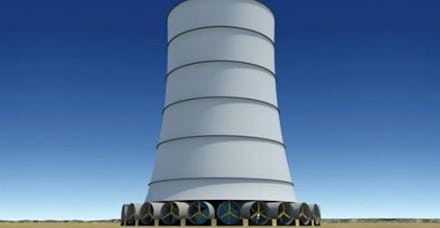This Weird, Massive Tower May Be the Future of Energy in the U.S.

The news: The country's largest freestanding structure will soon start construction — and it's going to be a solar-wind tower. Projected to reach 2,250 feet, it will be considerably taller than other American landmarks like the 1,454-foot Empire State Building. Designed by Maryland-based Solar Wind Energy Tower Inc., the solar-wind hybrid facility just secured funding to build its first model, which is projected to stand near San Luis, Ariz., by 2018.
How it works: A network of sprayers emits a fine mist of water droplets over the upper lip of the structure; the mist subsequently evaporates, absorbing the ambient heat of the surrounding atmosphere (that's the solar component). The result is dense, cool air that rapidly flows to the bottom of the structure. The air reaches up to 50 mph by the time it hits the bottom, where it is diverted outwards through a series of tunnels radiating from the inside of the tube. Those tunnels hold giant wind turbines capable of generating a lot of electricity.
As Motherboard notes, the concept was first patented in 1975, and Popular Science illustrated the idea in an issue in 1981, although its version of the aeroelectric tower really was improbably huge:
Image Credit: Popular Science
The entire project is estimated to cost around $1.5 billion. The company claims that at peak performance during July and August, the tower would generate up to 1,200 megawatt-hours. However, they believe it will only produce 435 megawatt-hours in an average month. For comparison, the largest nuclear plant in the country, at Palo Verde, Ariz., generates some 3,937 megawatt-hours, while the smallest, at Fort Calhoun, Neb., produces about 502 megawatt-hours. So while the tower will be a gigantic structure, it will resemble a relatively small nuclear facility in its energy generation — except without the radioactive waste.
Technical hurdles: To operate well, these downdraft towers need massive amounts of clean, fresh water (salt would seriously degrade components) and a hot, arid climate. Both factors deeply affect the towers' output, and their productivity would significantly decline during the winter. Another difficulty is that sites that fulfill these conditions tend to be rural areas with poor infrastructure.
Solar Wind Energy says it is also exploring sites in Mexico, which, along with the Middle East, Chile and India, possess the ideal climate for the technology.
Why we should do it: Though the renewable sector is growing fast, it's still just a small slice of America's overall energy production. Bold projects like the solar-wind tower could demonstrate that alternate energy sources are viable and well worth investing in, spurring technological innovation and the development of new economic sectors.